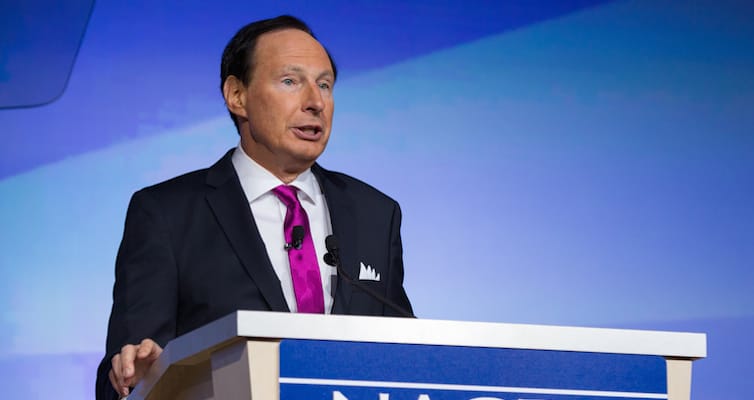
“NACDS and our allies have waged a pro-patient and pro-pharmacy effort at the federal and state levels,” said CEO Steve Anderson.
ARLINGTON, Va. — The National Association of Chain Drug Stores was working with member companies at presstime to review the final rule on Medicaid prescription reimbursements.
The Centers for Medicare & Medicaid Services (CMS) says the 658-page rule — which takes effect April 1 after a comment period — establishes a regulatory definition for average manufacturer price (AMP), which is the primary determinant of pharmacy reimbursements for certain generic drugs. The rule incentivizes pharmacies to dispense generics through regular updates of the federal upper limit (FUL) formula.
“This is the latest chapter in a decade-long saga that has required NACDS and our allies to defend pharmacy patient care against the potentially devastating cuts of the Deficit Reduction Act of 2005 — which was enacted in 2006 — and the regulations that were proposed to implement it in 2007,” said NACDS president and chief executive officer Steve Anderson. “We are at this point today because NACDS and our allies have waged a pro-patient and pro-pharmacy effort at the federal and state levels, and in the legislative, executive and judicial branches of government. We have advocated for policies that are appropriate from the perspectives of good government and of high-quality, accessible patient care.”
The final regulation also implements the Affordable Care Act provision extending rebates to covered outpatient drugs for beneficiaries in Medicaid managed care organizations. And it clarifies the definition of a manufacturer’s “best price,” aligning it with the AMP definition, where applicable, CMS said. Also clarified are definitions of “retail community pharmacy” and “wholesaler,” which the agency noted are key terms used in determining AMP.
In what has been a point of contention for pharmacies, CMS said the final rule aims to better align reimbursements with drug acquisition costs and ensure that states pay an “appropriate” professional dispensing fee.
CMS said key items in the rule for creating a fairer reimbursement system include:
• An exception to the FUL calculation allowing for use of a higher multiplier than 175% based on acquisition costs for certain multisource drugs.
• Actual acquisition cost (AAC) being the basis for determining ingredient cost reimbursement so payments are based on a more accurate estimate of available prices “while still ensuring sufficient beneficiary access.”
• Use of the term “professional dispensing fee” to make sure the fee reflects the costs of a pharmacist’s professional services and dispensing to a Medicaid beneficiary.
• The requirement that states assess the sufficiency of both ingredient cost reimbursement and professional dispensing fee reimbursement when proposing changes to either.
“The next step is to evaluate completely this final rule, and to hold it to the same standards that have motivated us consistently throughout the past near-decade: appropriate government policy making and accessible patient care,” he said. “As a member-driven trade association, NACDS will work with member companies to review the rule and to determine exactly where we stand.”
In a blog post, the National Community Pharmacists Association (NCPA) noted that CMS planned to publish draft FULs based on the final rule starting last month. Final FULs are slated to be published in late March. The association said states will have up to 30 days to implement the FULs, which will be updated monthly on the Medicaid.gov website.
NCPA said it aims to file comment on the final rule within the 60-day deadline. CEO B. Douglas Hoey said “in our very early read” there are several provisions that appear to demonstrate “that CMS listened to the evidence NCPA and others have presented to them and is treating community pharmacies fairly so they can continue to provide patient access to their services.”
John Gray, president and CEO of the Healthcare Distribution Management Association, commented, “The rule addresses a number of issues identified during the comment period — such as the treatment of bona fide service fees in the calculation of AMP, among others — and strikes an appropriate balance between ensuring continued access to necessary treatments for Medicaid recipients as well as fair reimbursement policies for pharmacy providers.”







